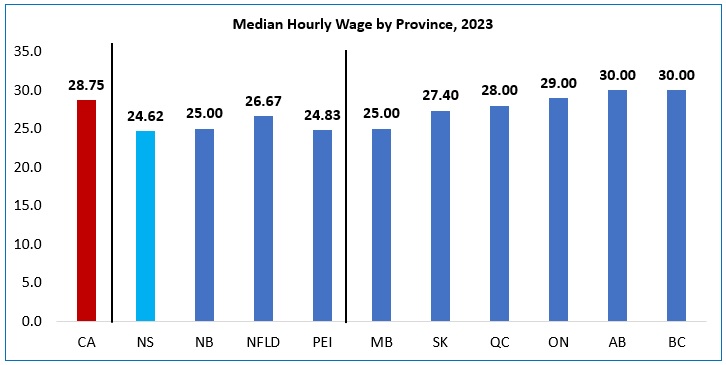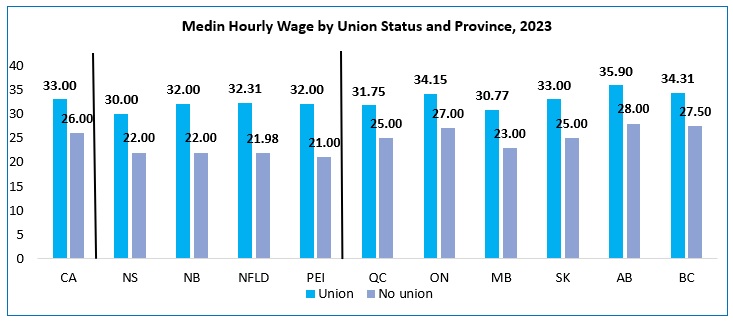- The median wage is the wage in the middle when you arrange all wages from lowest to highest.
- Minimum wage is the lowest amount of money that an employer is legally required to pay workers for each hour of work.
- Knowing how wages change over time helps us see how well someone is doing financially and provides clues about how the economy is doing.
Median wage – provincially and nationally:
In 2023, the median wage was $24.62 per hour. During 2023, the minimum wage went up from $13.60 per hour to $15.00 per hour.
Here is a breakdown of what happened with wages in Nova Scotia and across Canada in 2023:
- In Nova Scotia, the median hourly wage went from $23.08 per hour in 2022 to $24.64 per hour in 2023. That is a 6.7% increase and $1.54 per hour, which is slightly higher than the average increase across the whole country.
- Across Canada, the median wage rose from $27.00 per hour in 2022 to $28.75 per hour in 2023. This increase of 6.5%, or $1.75 per hour, in 2023 was higher than usual. Between 2018 and 2023 median wages in Canada went up by an average of 4.3% per year and averaged 3.2% per year between 2013 and 2023.
- In Nova Scotia, the median wage in the goods-producing sector went up by 4.0%, while wages in the services-producing sector went up by 5.3% in 2023 compared to 2022.
- Over the years from 2018 to 2023 in Nova Scotia, the median wage in the services-producing sector grew by an average of 2.9%, while in the goods-producing sector it grew by an average of 3.8%.
- In 2023, the median wage for males went up by 4.0%, and for females, it went up by 5.6% compared to 2022.
- Between 2018 and 2023, the median wage for males increased on average by 3.7%, and for females, by 3.9%.
- In 2023, full-time workers saw the median wage go up by 4.0%, which was more than the increase for part-time workers, which was 3.6%.

Calculations based on Statistics Canada Table 14-10-0064-01 (formerly CANSIM 282-0072) Employee wages by industry, annual, and Government of Canada minimum Wage Database - General Hourly Minimum Wage Rates in Canada since 1965.
In 2023, British Columbia, Alberta, and Ontario had the highest median average wage compared to the rest of Canada. On the other hand, Nova Scotia had the lowest median wage among all the provinces.
- In both 2022 and 2023, Nova Scotia, Prince Edward Island, and New Brunswick had the lowest median hourly wages in Atlantic Canada, with Nova Scotia being the lowest in the country in 2023 at $24.62 per hour.
- Prince Edward Island saw the biggest wage growth in the country, at 7.6%, followed by British Columbia at 7.1%.
- Alberta and British Columbia had the highest median wage rate in the country, at $30.00, followed closely by Ontario at $29.00. All three were higher than the national average of $28.75.

Calculations based on Statistics Canada Table 14-10-0064-01 (formerly CANSIM 282-0072) Employee wages by industry, annual.
Unions:
Wages for workers in unions are still higher than wages for those who aren’t in unions. The biggest difference in pay between union and non-union workers is in Atlantic Canada.
In 2023, in Nova Scotia, workers who were in unions earned a median wage of $30.00 per hour, which is $8.00 more than workers who weren’t in unions, who earned $22.00 per hour. Compared to 2022, median wages for unionized workers went up by 6.7%, while median wages for non-unionized workers went up by 0.3%.

Calculations based on Statistics Canada Table 14-10-0066-01 (formerly CANSIM 282-0072) Employee wages by industry, annual.